Ivory Diptych (10th-11th cent.)
This diptych from the early Middle Ages is carved from ivory and probably once served as book covers for some part of the Bible. The two sides depict Moses receiving the Law on the left, and Thomas touching Christ on the right. Medieval experts explain how the two plaques show two different ways that God offered himself to Man: through the tablet inscribed with his finger on the left and through the word-made-flesh, Christ, on the right. Interestingly, the Scripture inside these covers would have been written on parchment, or literally flesh, so the material itself figured the idea that the Word-is-made-flesh.1 What is missing in this kind of reading - as important as it is - is the artist's own identification with his work which we now explain.
Early medieval artists thought like mystics and in some cases were also monks as well working within the monastery. Many would have believed that the creative spark in their own minds was God's in that all creation, especially at this level of craftsmanship, is God's doing. Thus the hand of God on the left panel is also the artist's, a link further suggested by the fact that the shape of God's tablet mirrors that of the plaque itself.
Click next thumbnail to continue
Now note how God's hand is juxtaposed with Christ's larger-than-life hand on the other side, both on the same level. Christ's too must be the hand of the artist. His arm, though, curls curiously round his head. Why? This oddity draws attention to the fact that Christ's hand touches his head, indicating to esoteric viewers that divinity is inside the mind, not outside. It also suggests, in consequence, that Christ as an alter ego of the artist has created himself and that an artist needs to use, moreover, both hand and mind.
Click next thumbnail to continue
Thomas, of course, is always identified with the act of touching so is often an alter ego of the artist too. Here he faces into the work as the artist himself (or herself) would have done, his hands actively exploring Christ's body. Again Christ is his "work of art" which, as a reflection of Thomas (and the artist), "sculpts" himself.
Lastly, see how Thomas' finger points at Christ's feminine breast. It signals Christ's androgynous nature and thus the androgyny of the artist's mind too. In the Middle Ages, as Caroline Walker Bynum has shown, Christ was widely referred to in texts as both female and Mother.2 The same is true in art.
More Works by Medieval (Miscellaneous)
If you keep an eye out for underlying shapes, you might even be able to guess the artist's name

Antonio da Fabriano’s St Jerome in His Study (1451)
Notes:
1. Herbert Kessler, Seeing Medieval Art (Toronto: Broadview Press) 2004, p. 27. I also wonder whether the ivory itself, highly suggestive of bone, may not also have carried significance, perhaps indicating to esoteric viewers that divinity is inside us and that Scripture tells the story of our own minds.
2. Caroline Walker Bynum, "Jesus as Mother and Abbot as Mother" in Jesus as Mother: Studies in the Spirituality of the High Middle Ages (University of California Press) 1982, pp. 110-169
Original Publication Date on EPPH: 26 Oct 2010. | Updated: 0. © Simon Abrahams. Articles on this site are the copyright of Simon Abrahams. To use copyrighted material in print or other media for purposes beyond 'fair use', you must obtain permission from the copyright owner. Websites may link to this page without permission (please do) but may not reproduce the material on their own site without crediting Simon Abrahams and EPPH.





